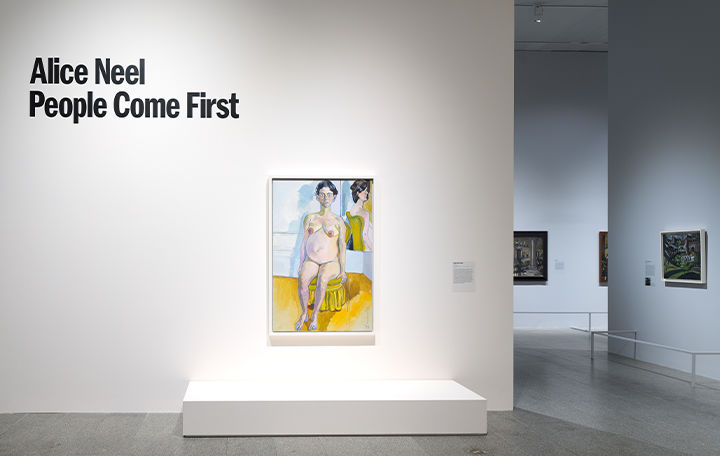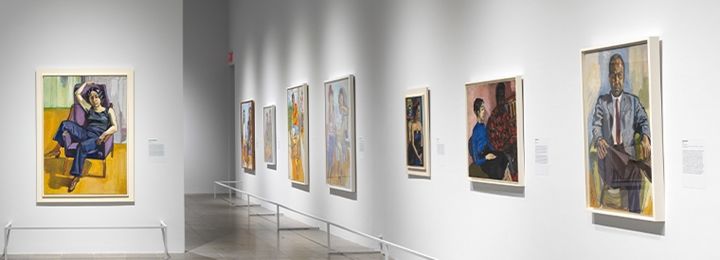
Alice Neel: People Come First presents Alice Neel (1900–1984) as one of the twentieth century’s most radical artists, a champion of social justice whose long-standing commitment to humanist principles inspired her life as well as her art. “For me, people come first,” Neel declared in 1950. “I have tried to assert the dignity and eternal importance of the human being.” In keeping with the ethical foundations of humanism, Neel dedicated herself to painting what she called “pictures of people.” The artist focused especially on individuals who had experienced injustice as a result of sexism, racism, and capitalism as well as those who combatted it. Democratic and inclusive, Neel painted people from many different backgrounds and walks of life.
New York was Neel’s greatest muse and the stage for a human drama she began capturing in the early 1930s. Neel’s life and art were inflected by the tumultuous events of the twentieth century, including the Great Depression, the rise of Communism, and the feminist and civil rights movements. For this reason, she described her work as a kind of history painting. Mindful of the formal and sensuous possibilities of paint, Neel applied her incisive eye to all her subjects, whether people, urban landscapes, or still lifes. Her riveting portrayals of life in New York, whose gritty beauty persists even in precarious times, make Neel’s art even more relevant in 2021.


Neel first arrived in New York in 1927, but only made it her permanent home in late 1931 or early 1932. She lived in the Bronx before moving to Greenwich Village, the epicenter of progressive politics in the city, and then settled in Spanish Harlem in 1938. Her final residence and studio, secured in 1962, was on the Upper West Side. Neel’s early encounters with leftist intellectuals and activists, as well as her work in the Federal Art Project (part of President Franklin D. Roosevelt’s New Deal in the 1930s and 1940s), led her to develop an enduring interest in “bearing witness” to life around her. Tapping into the urgency of collective action, her compositions focus on quotidian dramas and capture the challenges of a city that often tested its inhabitants, especially the marginalized and the poor. Neel notably painted many of her neighbors; melding the complexity and dynamism of urban life, she recorded for posterity the ethnically diverse immigrant population of Spanish Harlem that was rarely seen in twentieth-century painting.

Neel’s home was always her studio as well. All her apartments thus did double duty, serving as both domestic spaces and professional settings, places of intimacy in addition to work. For this reason, Neel’s various homes, whether in Greenwich Village, Spanish Harlem, the Upper West Side, or even her summer residence in Spring Lake, New Jersey, assert their presence in her work. Here, walls and windows, settees and chairs, function not just as settings and props for her pictures of people but also as protagonists in the encounters she depicted, from the erotic to the familial and the psychological. Staged in the spaces where the artist labored in many different ways, such works dramatize Neel’s dual responsibilities as a mother and an artist, a dilemma she referred to as that “awful dichotomy.”

Paintings of people by far dominate Neel’s practice, and though she disliked the term, she explored portraiture throughout her career. Her sitters included the many artists, activists, civil rights leaders, and celebrities who came into her orbit at different points throughout her life. She would even sometimes paint strangers who struck her as interesting, inviting them to sit for her, often a first step toward a friendship. Unconventional herself, Neel was drawn to individuals who pushed social, political, and cultural boundaries, from bohemian poets and labor organizers to queer performance artists and feminist trailblazers. Her paintings homed in on her sitters’ unique characteristics, with every carefully composed element serving to highlight both their personalities and their eccentricities. The panoply of Neel’s chosen subjects reflects the racial, ethnic, gender, political, and professional diversity of New York. Always astute, and occasionally arch, Neel merged in her paintings her progressive politics and artistic priorities.

As a means of articulating her own commitment to visualizing the human condition in its myriad complexities, Neel often invoked the title of Honoré de Balzac’s compendium of writings, The Human Comedy, which examines the causes and effects of human action on nineteenth-century French society. From a vantage point firmly rooted in twentieth-century New York, Neel sought to bring Balzac’s spirit to bear on her own historical moment, documenting episodes of suffering and loss, but also strength and endurance, with unsparing candor and acute empathy. Her attention to her subjects’ physical and psychological vulnerabilities imbues the paintings in this section with an unmistakable pathos, reinforced by an often-restrained palette.

From the very beginning, Neel’s practice was historically grounded and culturally engaged—as she once put it, “I believe in art as history. The swirl of the era is what you’re in and what you paint.” This section places select paintings by Neel in dialogue with a group of works drawn from The Met collection, which she visited regularly. Neel was generally disinclined to admit to artistic influence, and critics tended to describe her commitment to representation, especially in the 1940s and 1950s, as anomalous, but her oeuvre nevertheless reveals important connections to other artists. Neel’s training at the Philadelphia School of Design for Women, for instance, positions her as heir to the loose painterly realism of Robert Henri, whose teachings left a strong imprint on the curriculum. Her distinctive mode of direct painting-as-drawing is reminiscent of Vincent van Gogh, while her embrace of expressionism and perspectival disorientation recalls that of Chaim Soutine. Like Jacob Lawrence, Helen Levitt, and August Sander, Neel captured the pulse of the metropolis and its diverse human subjects with a gripping intensity. In just as many cases, however, she forged her own unique path, redefining well-established genres and departing from even those precedents set by other women artists. Neel’s desire to deromanticize both the female figure and the female experience, for instance, as seen in her nudes and images of mothers, stands in contrast to the work of Suzanne Valadon and Mary Cassatt.

Throughout her career, Neel foregrounded maternal labor, painting images of mothers at all stages of maternity, both pre- and post-partum, and such works are among her most radical. Unlike the fanciful, sanitized clichés that appear in popular culture and fine art, from beatific caregivers to saintly Madonnas, Neel’s mothers are both frank and concrete. Her paintings and drawings dramatize with equal parts candor and empathy the challenge of bearing and raising children. Herself a parent, Neel understood the physical and psychological pressures that accompany motherhood, especially for mothers with professional ambitions such as herself.

Recognizing the immense potential of the body as a site for exploring human experience, Neel painted nude figures of both sexes and all ages throughout her career. In the process, she reimagined one of Western art history’s most enduring if complex genres. Indeed, the nude posed particular challenges for women artists like Neel, given that women had long been the erotic objects in such works but rarely their subjects or authors. Neel both embraced and subverted this genre with aplomb. Notably, her male nudes, rendered with wit and sympathy, playfully engage with conventions of eroticism more often seen in representations of women. Neel’s extended focus on pregnant nudes was also unprecedented, and especially remarkable at a time when the subject was largely eschewed in visual culture. Her painted line sensitively traces the contours of plump bottoms, flaccid penises, sagging breasts, and taut skin, compellingly capturing the peculiarities, humor, and power of the nude human form, be it male, female, infant, octogenarian, pregnant, or coupled. In Neel’s paintings the naked body always appears without apology and in all its corporeal honesty.

Neel’s views on abstraction vacillated throughout her career. When figurative representation fell very much out of fashion in the 1940s and 1950s, her refusal to alter (or abandon) her style positioned her in contradistinction to the ascendancy, particularly in New York, of Abstract Expressionism. In this context, she publicly criticized abstract art, describing it as “anti-humanistic.” But her late-career reflection that all great painting has “good abstract qualities” indicates that formal and technical experimentation were always integral to her practice. This can be seen most evidently in her renderings of cityscapes and still lifes: beyond what their titles describe, these rigorously composed canvases are meditations in paint on the relationships of color, line, and form. Neel’s approach to abstraction is also amply present in her virtuosic use of negative space, be it pointedly patterned, chromatically hued, or, increasingly later in her life, deliberately left unfilled. For Neel, this unfinished aesthetic was quintessentially modern and seemed to function as a metaphor for the human experience—for becoming and un-becoming, beginning and ending, living and dying.
Alice Neel. Geoffrey Hendricks and Brian (detail), 1978. Oil on canvas. San Francisco Museum of Modern Art, Purchase, by exchange, through an anonymous gift. © The Estate of Alice Neel